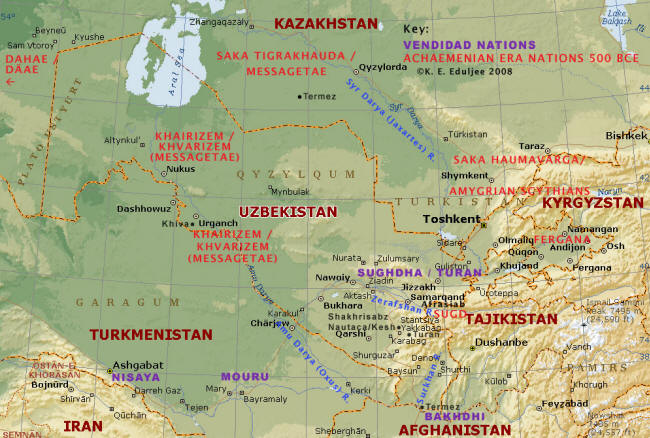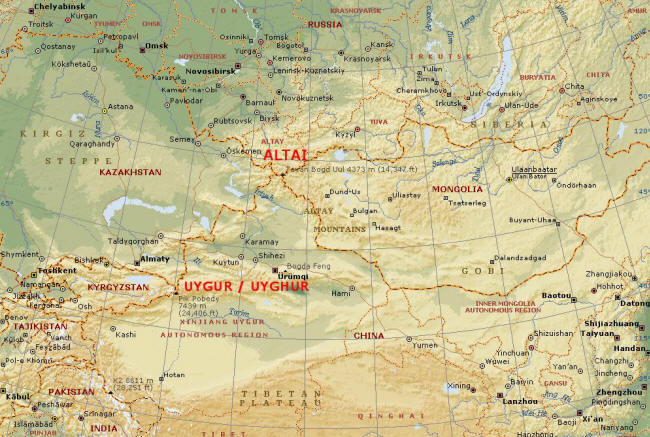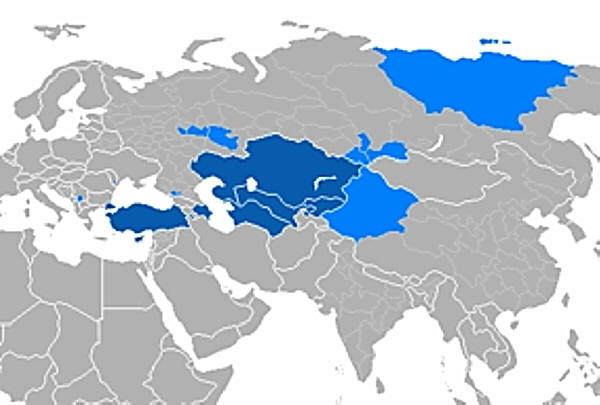
Contents

Uzbekistan Region
Uzbekistan Region & Zoroastrianism
Khvarizem
(Karakalpakstan Region)
Page 1
Introduction
Page 2
Page 3
Page 4
Additional Reading:
» Khvarizem (Khorezm, Khiva & Chorasmia)
» Sugd & Turan (Sughdha, Sogdiana, Tuirya)
» Soddian Trade. The Silk Roads
» Saka (Scythians) & Fergana
Uzbekistan - Eastern Frontier of Zoroastrian Lands
 |
| Map of Uzbekistan- Modern. Click to enlarge |
Out of all Central Asian countries, Uzbekistan has perhaps the greatest number of Zoroastrian related archaeological sites - sites that span the length and breadth of the country.
Uzbekistan is home to four principle rivers on whose banks Zoroastrianism took root:
• the Amu Darya (Gk. Oxus - Amu might be a derivative of Amul, now known as Turkmenabat. The name Oxus appears to be a derivation of Vakhsh, a tributary of the Amu Darya). In the Middle Ages, Arab geographers called it Jihun or Gihon perhaps confusing it with a river in Armenia,
• the Zerafshan (also spelt Zarafshan, Zeravshan or Zarafshon - meaning sprayer of gold in Persian. At one time the Zerafshan was a tributary of the Amu Darya. Today, however, the river disappears into the desert before it can reach the Amu Darya),
• the Surkhan (Darya), and
• the Syr Darya (Gk. Jaxartes. The Syr Darya traditionally formed the eastern border of Sogd as well as the Zoroastrian lands, passes through the eastern extremity of Uzbekistan. The Syr Darya was known to Greek writers as the Jaxartes or Yaxartes, a name derived from the Old Persian name Yakhsha Arta). As with the Amu Darya, Arab geographers called it the Sihun.
[Darya means sea in Persian indicating that the Syr and Amu Darya rivers were wide rivers in the past (today, waters drawn out for irrigation in the upper reaches have greatly reduced the size of these rivers.]
The nations that formed along these rivers are among the first mentioned in the Avesta - the Zoroastrian scriptures.
The Zerafshan River passes through Turan, mentioned in the Avesta's Farvardin Yasht as a nation where Zarathushtra first spread his message. The Amu Darya formed its western border.
Later in history, by the Achaemenian era c. 500 BCE, we find no mention of Turan in either Persian or Greek records. There, in the location where we would except to find Turan we find Sugd instead, leading us to conclude that Turan became Sugd or Sughdha (Gk. Sogdiana), the second nation listed after Airyana Vaeja (Aryan homeland) in the Avesta's Vendidad. Ancient Sughdha spanned land that is now part of both Uzbekistan and Tajikistan. While Tajikistan has a province called Sughd, a province that includes the Fergana valley (also shared with Uzbekistan), the lands within Uzbekistan are part of the provinces of Samarkand, Jizzax, Syrdaryo and Fergana. Sugd was the Central Asian hub of the Silk Roads.
The Southern Uzbekistan lands around the river Surkhan were part of the fourth Avestan nation, Bakhdhi or Balkh. The Surkhan is a tributary of the Amu Darya, which, having originated in the Pamirs (present day Tajikistan and likely a part of the ancient Aryan homeland - Airyana Vaeja), passed through Bakhdhi on its way to Khairizem.
The lower reaches of the Amu Darya supported the nation of Khairizem mentioned in the Avesta's Mehr Yasht. Khairizem's name would change to Khvarizem by the time the Bundahishn was written. In the old (western) Persian language of the Achaemenians, Khairizem was called Uvarazmiya a name which the Greeks wrote as Chorasmia. Khairizem (Chorasmia) was a nation of the Saka, a Scythian-like people, and the region today contains a large number of Zoroastrian-related archaeological finds.
The nations we have listed, did not all exist simultaneously. Turan appears to have been the earliest of the nations. Khairizem on the other hand appears to be one of the later states - created after the close of the Vendidad's writing, but before the creation of Media and Persia.
Present-Day Uzbekistan
 |
| Uzbek children and elder |
With a population of 24,755,519 (July 2000), Uzbekistan is the second most populous of the Central Asian countries after Afghanistan (31,889,923 - 2007). Like the other Central Asian countries, Uzbekistan is landlocked.
The modern capital of Uzbekistan, Tashkent (Toshkent), is located to the east of the Syr Darya river and adjacent to the historic lands of Fergana where two rivers join to make the Syr Darya (and incidentally, home to oil and cotton fields).
Culture
Uzbeks take pride in being hospitable people, a tradition of hospitality that has been extended to strangers from other lands since the times when traders plied their trade along the Silk Roads. Symbols of this tradition are the tea houses or chaikhanas.
Chaikhana - Tea Houses
 |
| Chai-Khana or Tea-House, Bolo Hauz in Bokhara |
 |
| Somsa freshly baked at a Khiva bazaar |
Chai-Khanas or Tea-Houses are time-honoured gathering places in Uzbekistan. Chai-Khanas are common throughout Central Asia, Iran and Northern India - the old Persian lands and lands through which the Silk Roads passed. They even share the same name, chai-khana, regardless of the language spoken in that country. In the chai-khana, traveller found a place to rest their weary feet, sip a cup of tea, eat wholesome food at a reasonable price and mingle with the local folks.
Today, since caravans along the Silk Roads have long since ceased, the chaikhanas have become meeting places for friends and the community. They remain for the visitor a place where they can mingle with the locals and sample Uzbek cooking that includes shashlyk, a kabob cooked and served on a long flat metal skewer, pilau (rice with meat and vegetables), kazan kabob (fried meat with potatoes) and other wholesome cooking.
Many Iranians and Indians will find Uzbek foods and the methods of food preparation to be familiar. For instance, the Uzbeks have a pastry stuffed with meat and onion called a somsa, similar in concept to the Indian samosa, but one with its own local flavour.
Ovens - Tandir
 |
| Tandir bread |
A further custom that Uzbeks share with other Aryan cultures is the clay ovens, called tandirs, used to bake Uzbek breads - an oven similar to the Indian tandoor. The bakeries are often located in or near bazaars, and are yet another place where a travelling trader could in days past, have found food to eat.
Bazaar
The bazaar, a form of marketplace common to many countries of the region, takes on special significance in Uzbekistan. The bazaars of Samarkand and Bokhara lay of the cross-roads of the Silk Roads, with branches going to Persia, Asia Minor and Europe in the west, India in the south, China in the east and the Saka countries in the north. In the days before sea trade eclipsed the trade along these roads, the bazaars featured wares from countries near and far.
The People of Old Uzbekistan
The people of the Avesta, the Airya (the people of Sughdha and Bakhdhi) as well as the Saka and people of Khairizem, were some of the earliest inhabitants of the lands that are now part of Uzbekistan - lands that eventually became part of the Persian Achaemenian empire until the defeat of the Achaemenians by Alexander of Macedonia in 330 BCE.
Alexander decided to stop his eastward advance at the Syr Darya since it formed the eastern boundary of the Persian empire. There in 329 BCE, he hastily put together a city naming it Alexandria Eschate meaning Alexandria the Furthest. In the city, he stationed a garrison and settled a group of retired wounded veterans from his army's invasions. Many of the Greek and Macedonia soldiers and veterans married local women and developed their own community, but not before 23,000 of the colonists revolted after Alexander's death, demanding to be sent home. They were not successful.
By the 2nd century BCE Greek / Macedonian control of lands east of the Oxus was nominal at best. The Saka and Sogdians had harassed their way to a measure of autonomy.
About two hundred years later, around the turn of the millennium, peoples from the north east, the Turkic people and Mongols gradually started to move in to the lands occupied by the Saka, lands that bordered the reformed Persian empire. The pressure the Turks and Mongols exerted would eventually displace the original inhabitants and push them westward. Of the Mongols and the Turks, the Turks would be the ones who that would form the majority population in Uzbekistan.
Turkic Peoples / Central Asian Turk
 |
| Map of Original Turkic and Mongol lands - Altai/Uygur. Click to enlarge |
The Turkic peoples and their Mongol cousins are thought to have originated in the areas in and around the Altai Mountains of Siberia. Gradually, the Turkic peoples occupied large tracks of Siberia and the Northern Uygur / Xinjiang Province of Northwest China. Groups emerged from within the Turkic peoples, some of whom were the Karluk (Uygur and Uzbek), Kipchak (Kyrgyz and Tatar) and Oghuz (Turkmen). To avoid confusion with the Turk of modern day Turkey, in these pages we will use Turkic to mean those people who originated in Siberia and settled in Central Asia.
While the Turks and Mongols share much in common they have nevertheless developed separately. Today the Turkic peoples are mostly Muslim while the Mongols are mostly Buddhist. The Turkic peoples have for the main part left their original lands while the Mongols returned to their original lands after their era of conquests. The Turkic peoples have also intermingled with the peoples in the lands to which they migrated, while the Mongols have maintained their identity.
In ancient times, the two groups were allies and while the population of the Turkic peoples far outnumbered the Mongols, the Mongols appear to have asserted most of the leadership within any alliance. The Mongol armies of Genghis Khan for instance contained large numbers of Turkic soldiers.
Both the Mongols and the Turkic peoples were a nomadic people who raided their south-western neighbours for for food and plunder. They were ruthless and killed entire Indo-Iranian settlements without mercy. The barbaric and cruel qualities that Ferdowsi ascribes to the Turanians are more correctly applied to the Turko-Mongols.
(Also see Arrival of the Turkic Peoples in our Khvarizem / Chorasmia page.)
 |
| Map of Turkic Language Peoples Worldwide |
 |
| Nomadic Turkic family relaxing outside their pastoral Yurt |
Within the last two thousand years, Chinese expansionism into territories beyond the Great Wall of China and into territories occupied of the Turkic peoples, displaced the Turks, pushing them westward (today Xinjiang and Inner Mongolia are part of China). In turn, the displaced Turkic peoples - sometimes on their own and sometimes allied with the Mongols - pushed the Indo-Iranians west and south populating the vacated territories. After a few generations or whenever they sensed any weakness, the more populous Turks displaced the descendants of the original Mongol overlords. Today, it is the Turkic peoples that populate Central Asia, Asia Minor and the Russian steppes, while the Mongols have either been assimilated into the local population or have returned to Mongolia.
Tamerlane (1336 - 1405 CE), born at Kesh near Samarkand, a member Barlas tribe rose to power and assumed control of Central Asia. While Turkic in identity and language, he claimed Mongolian ancestry from Genghis Khan. During Tamerlane's time, what is today Uzbekistan was still mainly Iranian in character. He felt the people of Khorezm were a threat to his power and ruthlessly displaced entire populations. The change to a mainly Turkic identity took place when the Uzbeks, a confederation of Turkic tribes, moved into Central Asia at the beginning of the 16th century CE, displaced the successors to Timur, and established their control of Samarkand in 1512 CE. After the Uzbeks had consolidated control, they divided the area into three states with Bukhara in the centre, Khiva to the north, and Khokand (Fergana) to the east.
Curiously, in the Central Asian states of Turkmenistan and Uzbekistan, the mainly Turkic residents identify strongly with the Indo-Iranian heritage of the area.
» Top
» Khvarizem (Khorezm, Khiva & Chorasmia)
» Sugd & Turan (Sughdha, Sogdiana, Tuirya)
» Saka (Scythians) & Fergana